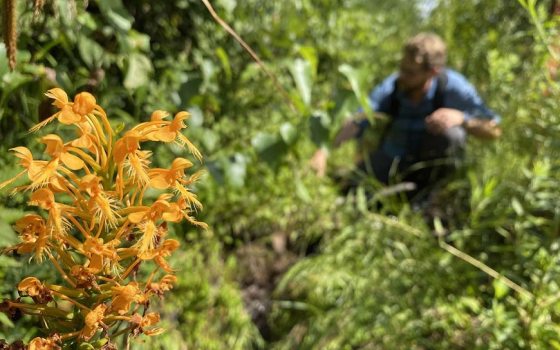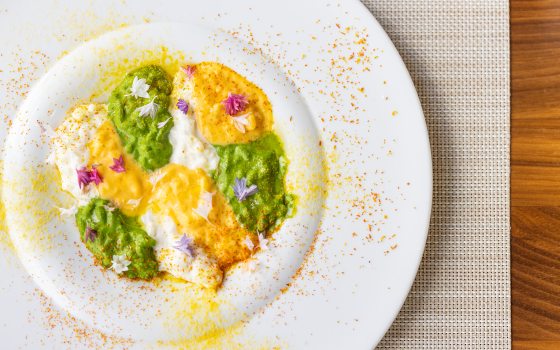Looking for a way to create a garden habitat to support some of the most flamboyant and exotic native plants in your home garden? A bog garden—or a habitat that uses slow-draining, permanently moist, acidic soil that mimics natural bog conditions—just might be your answer. Not only do bog gardens serve as a means of beautifying traditional gardens and enhancing plant collections, but they can also play a role in safeguarding rare plants and conserving the flora and fauna of globally rare and threatened ecosystems. Come take a tour of my personal bog garden, its microhabitats, and the plants best supported in this unique space.
A bog garden is a raised bed or excavated area lined with an impermeable layer such as a pond liner or roof liner, filled with a substrate that supports the growth of plants that need constantly wet to damp, acidic conditions to thrive. It should be situated in full sun or areas that get at least 6 hours of direct sunlight. Ideally, beds should range from 12 to 30 inches deep and the generally recommended medium is a roughly 50:50 mix of sphagnum peat (from compressed rectangular bales) and silica sand; blasting sand is typically recommended. Local sand can also be used if it does not contain lime. Although not intuitive, it’s often preferred to create a bog garden on a gradual slope, where water can slowly seep out, resulting in permanently damp or wet, but aerated, soil. Bog gardens are usually at their peak in the summer months, so it’s best to start them in in the early spring so the plants have a time get their roots established. Thoroughly mix the medium to ensure a homogenous blend and be sure to pack the soil as you add it to the bog garden space—I had my kids stomp on it as I filled my bog garden. This step ensures that any extra air in the medium is expelled and that the plants have a firm medium to root into.
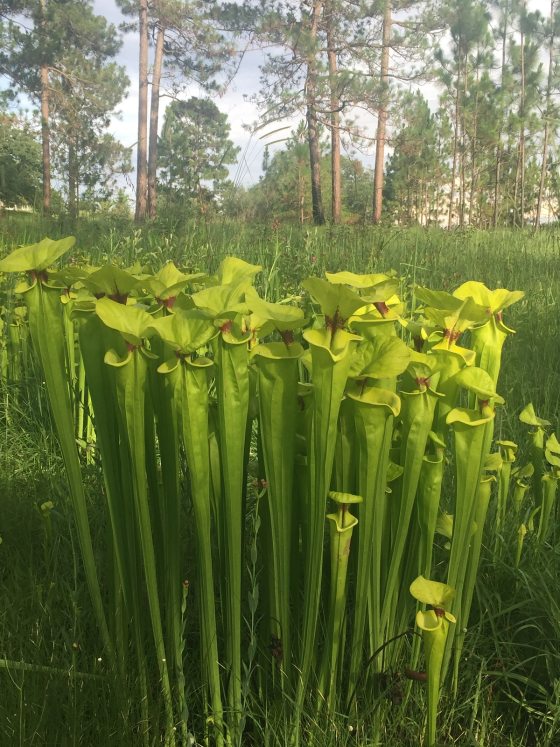
Bog gardens are miniature representations of sphagnum bog ecosystems found scattered throughout Pennsylvania, the southeastern United States, and elsewhere. In the wild, these habitats form in different ways, but all possess the unifying characteristics of being completely damp or wet, remain open due to sphagnum moss cover or other factors (such as fire), and are nutrient-poor. These habitats support a large array of native plants including many types of carnivorous plants, orchids, ericaceous plants (blueberries and their relatives), many types of grasses, and much more. Bog habitats and the plants they support have become rare in the wild. Although they were never common in PA, human disturbances have resulted in the disappearance or significant alteration of many formerly known bogs, causing many of the plants and animals inhabiting them to be listed as threatened, rare, or endangered. As a side note, Longwood scientists are working at bogs in Pennsylvania (as seen in the first image of this post image) to help learn about orchid species conservation in these habitats.

In my home bog garden, which is about 30 feet long and of variable width, the upper part of the bog is 18 inches deep and filled with 50:50 sand to peat. Immediately next to it on a gradual slope is an area of pure, 12-inch-deep sand that supports drainage and filtering of water from the upper part of the bog. In the summer, the top layer of sand is completely dry, but damp to wet 3 to 6 inches down. I’ve varied the depth of the medium and the ratio of sand and peat mix in order to not only create conditions more representative of natural bogs, but to also create microhabitats for growing plants that require different conditions, even though those plants remain in close proximity to one another. Over time, some plants can find their own preferred part of the garden through natural reseeding.
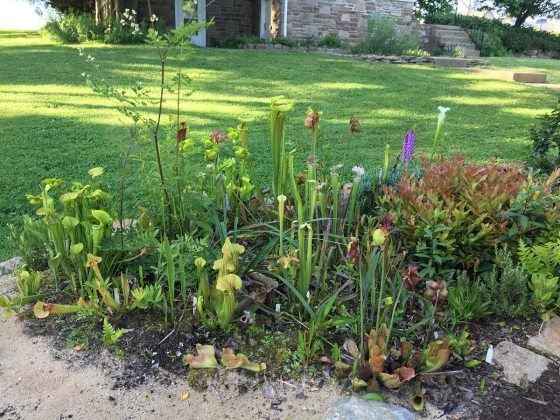
What plants are best for your own bog garden? Many bog gardens are designed and installed to accommodate a collection of the charismatic flora of the eastern North American coastal plain and sphagnum-filled bogs of the recently glaciated Midwest and far north. Sarracenia— the carnivorous North American pitcher-plants—are the staples of bog gardens, including in my own, where I focus on growing species and hybrids of known wild origin to serve as a reference conservation collection, as well as to showcase unique variants not typically seen in the gardens. Pitcher-plants are ornamental from May through summer and into fall. Their large, exotic flowers (which were popular with florists in the 1960s) occur in May in a range of colors from yellow to red and pink are followed by the exotically colored leaves which are modified to trap and digest insects. If you are new to growing pitcher-plants, some of the best to start with include S. flava, S. purpurea, and many hybrids. Sarracenia are among the most commonly poached plants from the wild and most are now protected where they occur. There are many sources where plants can be found commercially, and they are extremely easy to grow from seeds. They are much more cold-hardy than their southern origins would indicate, with most being reliably cold hardy into USDA hardiness zone 5.
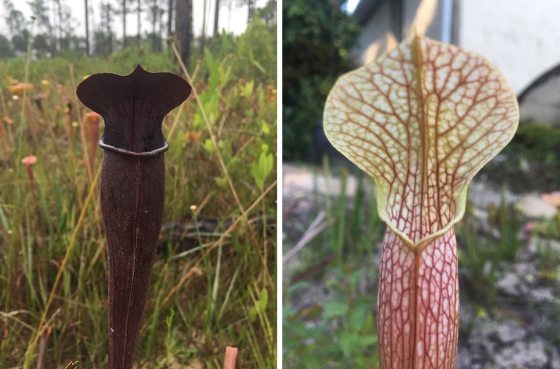
The plant that inspires most people to construct a bog garden is the U.S. native Venus flytrap (Dionaea muscipula). It’s a common misconception that this well-known plant comes from far-flung tropical jungles. In fact, it’s native to a small area of the North-South Carolina border where it is very rare in the wild. Venus flytraps are commonly available for sale from a variety of sources and often cultivated as houseplants, where they inevitably fail, as like other temperate plants they need a cold, dormant period to continue growing. They are surprisingly hardy into USDA hardiness zone 5, and make ideal components of any bog garden.

Shrubs are an important, but often overlooked, component of bog gardens. In my experience, the root systems of shrubs are vital for helping circulate moisture through the medium and mitigating soil moisture during extremely wet periods as well as providing additional microsites for smaller, less vigorous plants such as butterworts (Pinguicula) and orchids. Several native shrubs can be considered, such as bog-rosemary (Andromeda polifolia ‘Blue Ice’), which has been a bog garden stalwart with me for the last 10 years. It survives extremes of heat and cold, looks good throughout the year, and rarely needs pruning. One shrub to avoid is the cranberry (Vaccinium macrocarpon). While charming and easy to grow, it soon grows out of the control and smothers neighboring plants. The cultivar ‘Hamilton’, however, is extremely dwarf and slow growing, making it an ideal candidate for bog gardens.
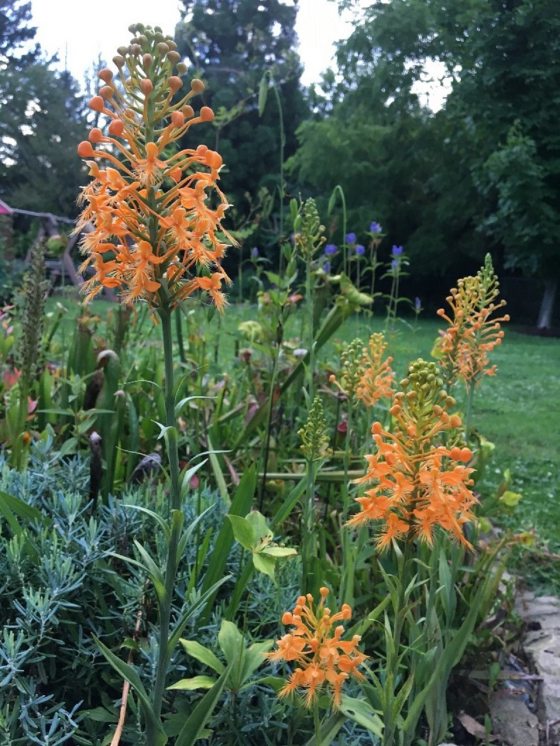
Orchids are among the stars of the bog garden and one of the primary reasons I started to experiment with them. The easiest bog garden orchid is the grasspink (Calopogon tuberosus). This Pennsylvania native produces bright pink flowers throughout the month of June, and will even reseed into other parts of the bog garden in the right conditions. Some of the fringed or bog orchids of the genus Platanthera are readily grown in bog gardens. The orange fringed orchid (Platanthera ciliaris), and its white flowered counterpart, P. blephariglottis, thrive and reliably flower in mid-summer along with many of the lilies and provide another source of nectar for swallowtail butterflies. The bog garden is an ideal place to try a wide variety of temperate terrestrial orchids. Like pitcher-plants, most orchids are protected in the wild and should be left there. Some mail order nurseries offer ethically produced orchids that can be purchased for planting in bog gardens.
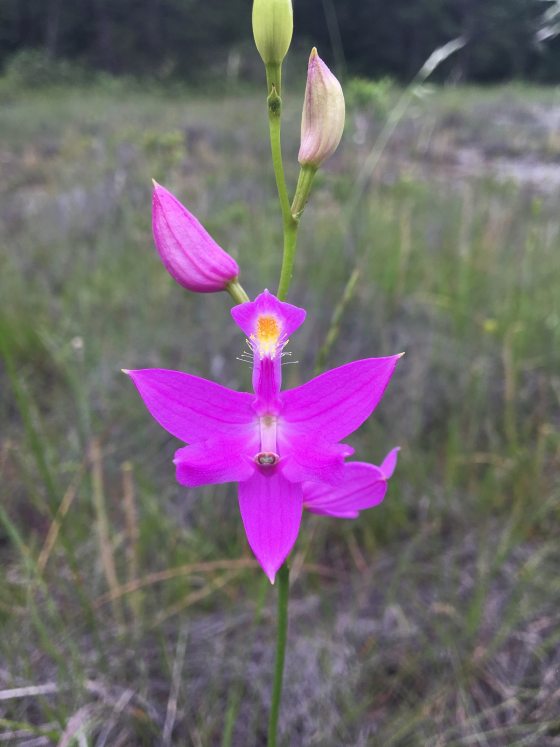
Like other types of gardens, bog gardens come with their fair share of “weeds,” both good and bad. One of the most rewarding bog garden weeds is orange milkwort (Polygala lutea). Affectionately known as “bog Cheetos” in some gardening circles, this biennial is one of the hallmarks of the sunny bog garden. It produces dense heads of golden-yellow flowers from June until frost in my garden and seeds itself into appropriate areas of the garden, but never aggressively so. The sundews (Drosera spp.), another well-known group of carnivorous plants well suited to bog gardens and with many cold-hardy, native species, also fall into this category. Individual plants are not long-lived but reseed in appropriate conditions.
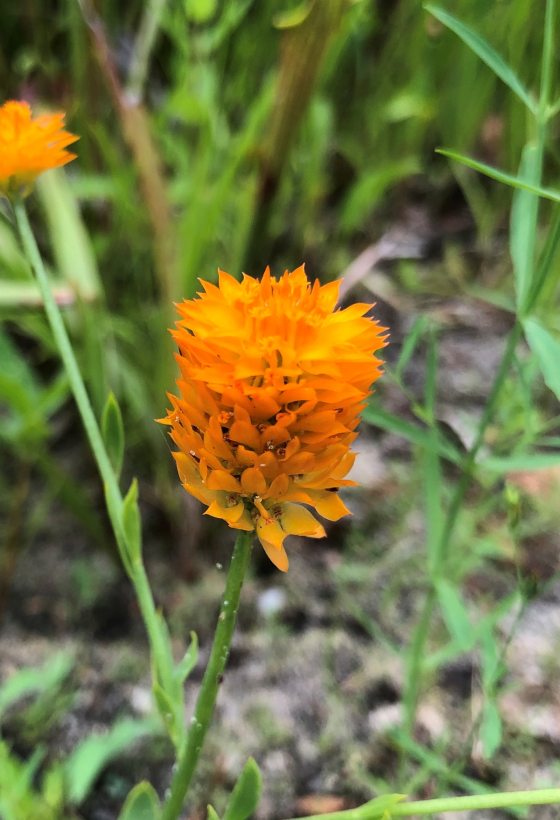
No matter which plants you choose for your own bog garden, they should be sourced from nurseries with responsible and sustainable propagation and production practices. There are several mail order nurseries that sustainably produce bog garden plants. If you’re looking for something a bit more challenging, many bog garden plants are easily grown from seed and seeds are often found through various seed exchanges produced by special interest plant societies. Although there may be substantial initial effort when creating your own bog garden, the ease with which such choice plants can be grown is instantly rewarding, long-lasting, and beautiful while providing a glimpse into the diverse and exciting world of native plants.
